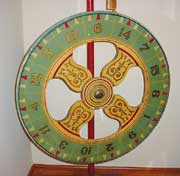|
Dock of the Bay
 The Constant Constellation Keeps Making History The Constant Constellation Keeps Making History
At 150, the Historic Ship Makes Baltimore-Annapolis-Baltimore Round Trip
If ship’s logs competed for Pulitzer Prizes, the USS Constellation’s would be a contender. The captivating history of the sloop of war made the biggest impression on many who came to visit her last week in Annapolis, where she docked at the U.S. Naval Academy for six days of public tours.
“I never knew the ship was involved in so many different events in our country’s history,” said a Montgomery countian who toured the Constellation at her visit last week to celebrate the 150th anniversary of her launching.
The Constellation’s resume includes flagship duty, protector of commerce in the Mediterranean, liberator of Africans from slave ships, training vessel and Civil War blockader. She also delivered relief supplies to Ireland during the 1880s’ famine.
Nearly as wide a variety of people boarded the vessel last week, either taking tours or giving them. As the Severn lapped against her hull, pleased kids followed instructions on raising and lowering the capstan by stepping up onto the hatch and back down again until a rope lifted a barrel.
“See how they let it out now,” a grandfather — with a capstan on his own sailboat — advised his two young granddaughters.
 |
photos by Louise Vest
Reenactors man the lines aboard the USS Constellation, left, which docked at the seawall outside the U.S. Naval Academy where the sloop of war was once used in training exercises. |
There were lessons for grown-ups too.
Enlisted men and women from the nearby naval station saw how their counterparts worked and lived in the economy of space of the last all-sail ship built by the Navy. Academy midshipmen saw how their predecessors learned seamanship 111 years ago.
Volunteering as guides were Constellation devotees, each bringing a favorite historical footnote.
“The Constellation was the flagship of the Commander in Chief U.S. Atlantic Fleet during the first months of the war,” said John Barnard of the ship’s World War II experience.
Constellation has fan clubs, too. Those cadres got to dress up in Civil War Union naval uniforms, board and work their living-history magic. One group, Ship’s Company, has members who hail from all over the United States. One member, on active military duty, flew in from Korea; another came from Washington state.
History was made as well as celebrated on the Constellation’s voyage to Annapolis. At her age, taking a sailing journey, even in tow, is an accomplishment.
Now, the Constellation has taken a second journey, returning to Baltimore’s harbor. But last week she belonged to Annapolis, and many who boarded her said they felt fortunate to see her as her masts pierced the skies above the Severn and the wind from the Chesapeake filled her flags.
For Baltimore tour and information: 410-539-1797.
—Louise Vest
 |
photos by Carrie Steele
Newman Street Park is closed now, except for the new playground, but all should be completed by June 2005. |
Earth Moving at Newman Street Park
Plan to Try It out Next Year
Soon, you’ll be able to meet friends, walk your dog or just relax at downtown Annapolis’ Newman Street Park.
Cracked urban-esque asphalt went under the jackhammer at the end of September. Utilitarian benches and rusty chain-link fences have been sent to the landfill. A bright yellow back-hoe bites chunks out of coffee-colored soil, and fluorescent-orange plastic fencing surrounds the whole operation.
The restored park [“Reinventing Annapolis’s Newman Street Park, Vol. XII, No 27: July 1] will face City Dock with an inviting brick walkway, fresh landscaping, a bioretention raingarden, two sitting walls, new rust-resistant fencing for the basketball court, new park benches and new drinking fountains.
The park is closed now, except for the new playground. Construction didn’t, however, close the walkway on Compromise Street for Boat Show traffic.
“The contractor’s looking at a 90- to 120-day construction period,” says Recreation and Parks’ director LeeAnn Plumer. “He feels he can get it done by the end of year.”
That’s what park-partner Rotary of Annapolis expects.
“Our doing this park is part of the centennial celebration of Rotary,” says the club’s president Ron Baradel. “So it has to be completed by June of 2005.”
—Carrie Steele
 |
photo by Grace Mary Brady
A roulette wheel on display from Calvert’s gambling days. |
You’ll Wish You Were There
Bayside History Museum Preserves Good Old Days from Galesville to Breezy Point
When you visit the brand-new Bayside History Museum in North Beach, there won’t be sizzling hamburgers and hotdogs — not even a piece of cake, let alone a whole sheet.
And you’ve missed the politicians, from Maryland senators Mike Miller and Roy Dyson to fresh-minted delegate Sue Kullen and newly appointed secretary of veterans affairs George Owings, who she replaces, to Calvert County commissioners Linda Kelley and Wilson Parran to North Beach mayor Mark Frazer.
You won’t hear the story about the unfortunate whose death was officially attributed — or so Frazer said — to “Thunderbird wine and the North Beach environment.” That, too, was special to the October 29 grand opening of the area’s newest museum.
But when you come, you’ll see pictures worth a thousand words — and memorabilia worth two thousand — just as the opening day crowd saw once the yellow ribbon barring early entrance to 9006 Dayton Avenue had been snipped.
You’ll see slot machine and roulette wheel, peanut vending machine and table-top juke box, cash register and bar stools, souvenirs, old duds and old photos.
“I liked the restaurant memorabilia, the menu and matchbooks from Rod ’n’ Reel, the handouts my grandfather Wesley Stinnet had given out on Mother’s Day,” said Joan Kilmon of Dunkirk, for whom the museum preserves the history of a family in the restaurant business to this day. Her brothers, Gerald and Fred Donovan, are today’s owners of Rod ’n’ Reel.
“I like the slot machine,” said Barbi Shields, Fairhaven representative on the board. “Long before we were of age, we could come over to Chesapeake Beach and plays the slots.”
“I like the swimming pool locker tag,” said Mary Mattingly of North Beach. “It reminds me of my father, who’d wear one just like it on his ankle when we came down here to the old waterpark when I was a kid.”
A pair of museum stalwarts, Gracie Rymer and her daughter Grace Mary Brady, trace their roots to the museum itself. The freshly painted green-on-green Dutch flying-A house was home of Charlie Meade, brother to 1950s’ town mayor Robert Meade as well as uncle and great uncle to Rymer, who represents Camp Roosevelt on the museum board, and Brady, its president.
“Each picture and thing is part of someone’s life and is here because someone saved it and shared it,” Brady told the high-spirited crowd. “Someday we won’t be here, and these things will tell the story of then — and now.”
Mead’s house was slated for destruction when Frazer redeemed it from Fannie Mae for $99,000, then spent another $35,000 to restore it, transforming it into a museum fell to the North Beach Historic Commission.
Now it bears the name of Thelma Robinson, North Beach town secretary for 49 years. “It’s wonderful recognition,” said Robinson, sitting in the open doorway as crowds poured in to remember who they were and where they came from.
“I like it because you can go in and see your history,” said Joy Broome. A lifelong North Beach citizen, Broome said her grandfather founded the town’s — hence Calvert County’s — first fire department. Among the artifacts inside the new museum were souvenir coins and albums she’d contributed.
As the new collection sparked stories of the good old times, newcomers could only wish they had been there. The draw of history was not overlooked by the politicians, whose job is to look at the future of the places they represent.
“Two things draw people to an area: shopping and museums, especially historic ones,” said Sen. Roy Dyson. So, he said, “as they say in the south part of St. Mary’s County, ‘Gee by golly,’ you’ve done a good job.”
Added Frazer, whose job as mayor is to keep his eye focused on North Beach: “We needed one other attraction besides the waterfront. Now we’ve got a history museum.”
—SOM
Ask the Plant Professor
Leaves, Old and New
Q I have a wooded area at the property line where we have deposited our leaves. Will they decompose on their own or must I do something?
A Leaves decompose naturally. A few inches of leaves should break down in a year; however over eight inches of matted leaves may not. To speed up the process, mow or mulch your leaves and layer them with green materials — grass clippings, vegetable waste — or compost. Also, turning the leaf pile speeds up the composting. Once composted, they’ll be an excellent addition to your garden and landscape soils.
Q We have almost an acre of land. Over the past few years we have managed to get rid of most of the English ivy the previous owner let take over. We would like to make a natural perimeter with native shrubs and trees for privacy. Is there a website or publication that lists plants native to our area?
A We commend you for eradicating the English ivy (an exotic invasive plant that does not hale from England incidentally) and planting native trees and shrubs. Our publication HG 120 Native Plants of Maryland: What, When, Where ($5) has what you need. American holly, inkberry, mountain laurel, magnolia grandiflora, and Eastern red cedar are all evergreen possibilities. Bonus: we’ve never seen deer eat a mature American holly.The Maryland Native Plant Society has a very informative website (www.mdflora.org) with a list of nurseries that sell native plants in our area.
Ask the Plant and Pest Professor is compiled from questions sent to the website of the Home and Garden Information Center, part of Maryland Cooperative Extension, an educational outreach of the University of Maryland. Ask a home gardening or pest control question and find other help: 800-342-2507 (Mon.-Fri. 8am-1pm) • www.hgic.umd.edu.
Way Downstream
In Washington, they’re planning to build a fancy new baseball stadium on the Anacostia River. But the sorry Anacostia remains a dumping ground for human waste, trash and chemicals, the Chesapeake Bay Foundation concluded in a report last week. The first goal: forcing the District of Columbia to fix its antiquated sewer system …
In New England, they’re complaining about the fifth consecutive disappointing display of fall foliage, and experts are blaming global warming. Winters have gotten warmer, reducing the number of hard frosts that kill the chlorophyll in the leaves, which in turn prevents the brilliant color display that people had grown accustomed to, researchers say …
In Spain, a new study from the University of Santiago de Compostela suggests still another benefit from red wine: protection against lung cancer. But the study also concluded that drinking white wine slightly increases the chances of getting lung cancer.
(Could it be that people had one hand on their wine glass and another around a cigarette?) …
Our Creature Feature comes from Boulder, Colorado, where University of Colorado professor Brian Toon has a theory about what killed most dinosaurs: a “day from hell” when an asteroid hurdled into earth 65 million years ago, scorching everything not living in water or burrowed in the ground.
Toon’s paper, published in the Geological Society of America bulletin and presented at a conference in Mexico last week, theorizes that many creatures were vaporized immediately and others drowned in huge tsunamis when the asteroid plunged into today’s Gulf of Mexico. As a deft Reuters writer put it, “One minute you’re a big T-Rex, the next you’re toast.”
to the top
|


 The Constant Constellation Keeps Making History
The Constant Constellation Keeps Making History


